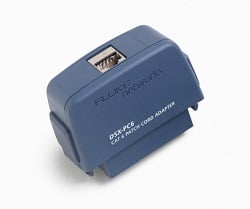 You may have worked on deployments where a horizontal cable run terminated on one end to an RJ-45 plug connects directly into a device. If so, then you have worked with a Modular Plug Terminated Link (otherwise known as MPTL). Formerly known as a "direct attach connection" and previously recognized in building automation and electronic safety and security standards, the MPTL is now recognized in the recently approved ANSI-TIA568.2-D as an option for connecting devices where it is deemed impractical or unsafe to deploy an outlet and equipment cord. It's essential that you recognize where MPTLs are better suited for connecting devices instead of traditional outlets, faceplates and equipment cords. Fluke Networks has you covered when it comes to testing.
You may have worked on deployments where a horizontal cable run terminated on one end to an RJ-45 plug connects directly into a device. If so, then you have worked with a Modular Plug Terminated Link (otherwise known as MPTL). Formerly known as a "direct attach connection" and previously recognized in building automation and electronic safety and security standards, the MPTL is now recognized in the recently approved ANSI-TIA568.2-D as an option for connecting devices where it is deemed impractical or unsafe to deploy an outlet and equipment cord. It's essential that you recognize where MPTLs are better suited for connecting devices instead of traditional outlets, faceplates and equipment cords. Fluke Networks has you covered when it comes to testing.
Retail, Education and Hospitality
In retail, education and hospitality environments, cabling system deployments can include a multitude of connections to support surveillance cameras. When a surveillance camera connects to an exposed outlet with an accessible equipment cord, it's pretty easy to disconnect it from the network by simply pulling the cord directly out of the camera. If security is a top concern for you or your customer, MPTLs may be the right solution. MPTLs can enter directly into the camera from behind the wall or ceiling to which it is attached. By eliminating the outlet, faceplate and equipment cord, you make it much more difficult to unplug the camera.
Cost Savings and Aesthetics
Security is one of the top reasons to use MPTLs to connect devices, but cost savings and aesthetics can play a role in the decision-making as well. In the era of the Internet of Things (IoT) and intelligent buildings, more devices than ever - LED lights, WiFi access points, building automation controls and more - before reside on the network, and many of them likely require connections in the plenum space. Not all outlets and patch cords are plenum-rated as required by code, and using MPTLs with plenum-rated cable eliminates this concern.
MPTLs can also help cut costs by reducing an overall bill of materials and allowing for faster deployments since there is no need for terminating cable to outlets, installing the outlets into faceplates and making connections with equipment cords. This is particularly pertinent for devices that will not need to be moved to a different location and can remain where they have been installed, like desktop computers, VoIP phones or printers.
Additionally, eliminating outlets and equipment cords can provide a neater, cleaner appearance for environments where looks matter - no one likes to see an equipment cord hanging down a wall from a video display to an outlet.
Testing MPTLs
With the proliferation of MPTLs, you could end up with several horizontal runs that are no longer a typical four-connector channel. To certify these links, you will need to follow the new standards-based test procedure that verifies the performance of the final plug connection at the device end.
Included in the new ANSI-TIA568.2-D standard is the proper MPTL test procedure, which uses a Permanent Link Adapter, such as Fluke Networks' DSX-PLA004 or DSX-PLA804, on the main unit and a single Patch Cord adapter, such as Fluke Networks' DSX-PC6A, DSX-PC6 or DSX-PC5e, on the remote unit at the far end.
The good news is that, rather than having to purchase a pair of patch cord adapters like you would have to do for patch cord testing, Fluke Networks now pairs a single Category 5, 6 or 6A patch cord adapter with the DSX Permanent Link adapter (included with all DSX CableAnalyzer models) to perform MPTL certification. The adapters are compatible with all DSX models. The new MPTL test limits are also included in the latest version of the Fluke Networks' Versiv-DSX firmware for use with DSX CableAnalyzer™ Series Testers.
Click here to contact your local Accu-Tech representative to talk about how you can start testing and certifying MPTLs with Fluke Networks' solutions.



.png?width=58&height=58&name=X_logo_2023_(white).png)
